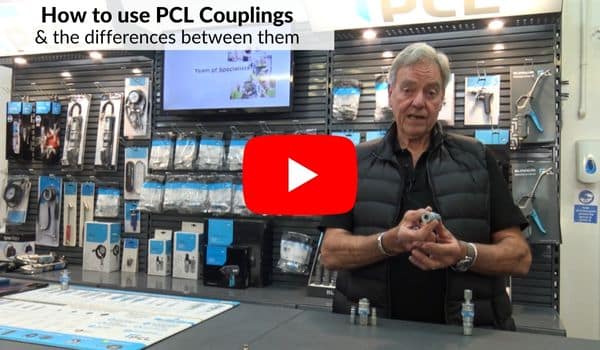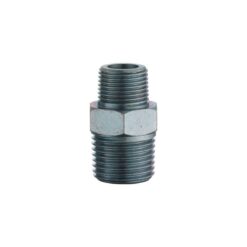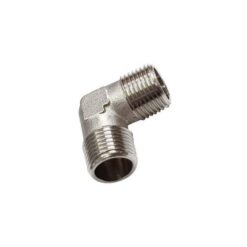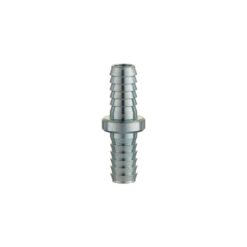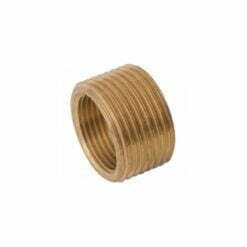When it comes to air compressor fittings (couplings and adaptors), industry jargon can often be confusing. For this reason, we hope this guide helps you find the right adaptors, couplings and connectors for the job you have.
Understanding Air Compressor Fittings
First of all, let’s clear up some industry jargon and what it means.
Couplings
Couplings are often referred to as either “sockets” or “couplers”. The non-threaded end (socket) that connects to an adaptor is always female.
Couplings can come in many different shapes and sizes, below are a few examples of a few:
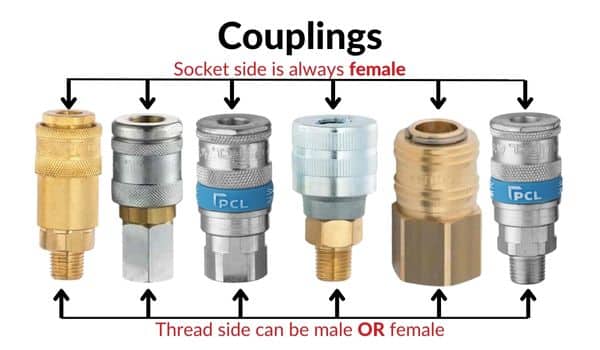
Adaptors
Adaptors are also known as “plugs” or “nipples”. The non-threaded end (plug) that connects into a socket is always male. The Shape of the Male part is its ‘Profile’, which is important as most are not interchangeable.
Adaptors come in many different shapes & sizes and have varying nominal bore sizes too. Below are a few examples:
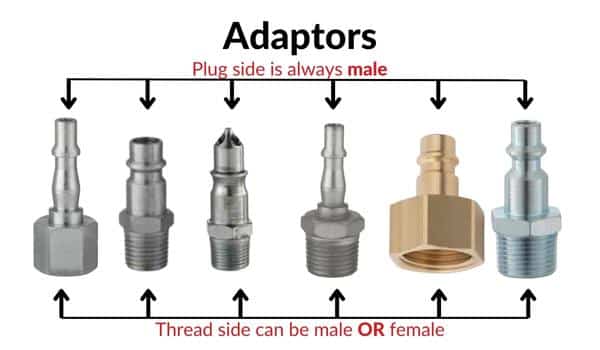

Browse our range of Couplings & Adaptors >
Actual Size Adaptor Profiles
Below is an image showing the actual size of the adaptors we sell. You can hold your adaptor up to the screen to see which one you have. Important: Please note that you will need to be on a desktop computer to do this, mobile devices will NOT display actual sizes.
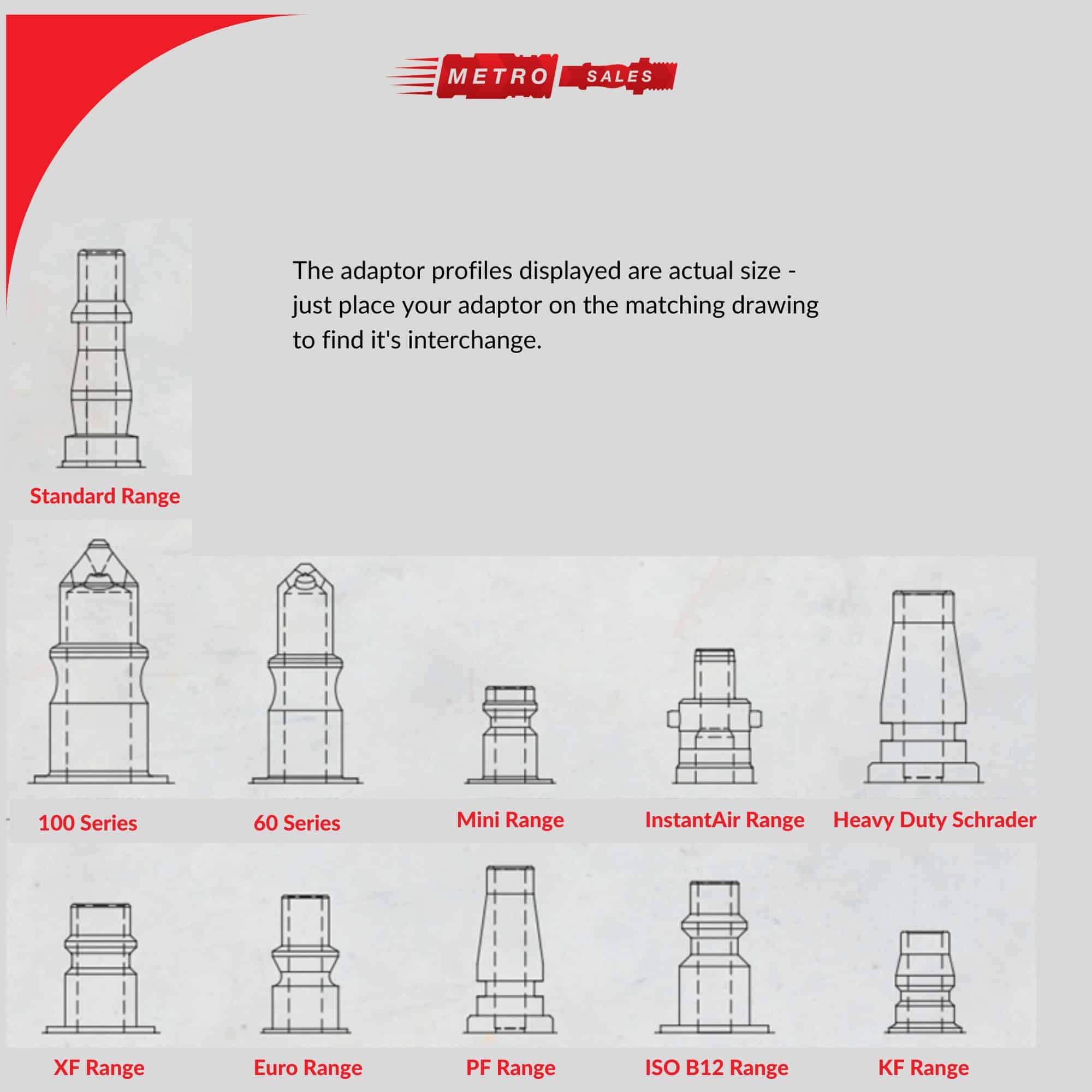
Nominal Bore
Nominal bore is the term used for the internal diameter of the hole that runs through the length of the adaptor. In other words, the size of the hole that the air passes through.
BSP
BSP stands for British Standard Pipe. It is the most commonly used type of thread in the UK to measure air fitting thread sizes. Just to confuse matters, thread sizes are based on trade sizes rather than the actual dimension that it is.
Here’s where it gets even more confusing!
There are 2 different types of thread within the BSP category (BSPP and BSPT), the main difference being the type of thread they have.
What is the difference between BSPP and BSPT?
BSPP stands for British Standard Pipe Parallel (also known G or Rp)
BSPP fittings are straight (i.e parallel) and usually FEMALE in the UK, although there can be some male threads. The air-tight connection on a BSPP thread is made on a washer or ‘O’ ring.
BSPT stands for British Standard Pipe Tapered (also known as R or Rc)
As you probably guessed, BSPT is a tapered thread (and usually MALE in the UK). An airtight seal into a parallel female is made using PTFE Tape or Liquid thread sealer.
How to Measure the A Coupling to Work Out the BSP Size
Step 1: Measure the thread
It’s always easier to measure a male thread rather than a female thread. This is because it stick out and is easier to see the measurement on a ruler.
A general rule of thumb is that if you have a ¼” BSP male thread, then it will screw into a ¼” BSP female.
Measuring a Male Thread Coupling
To measure a male air fitting:
- Use a ruler to measure across the outside diameter of the thread and note the measurement in millimetres.
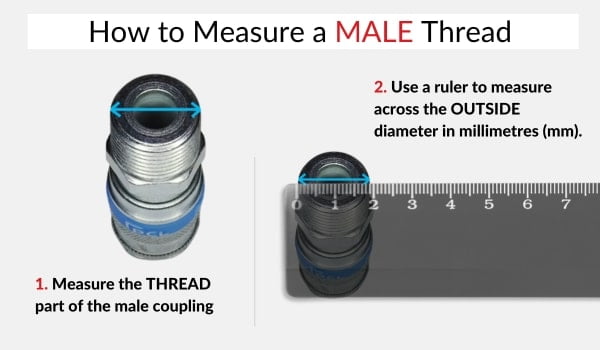
Don’t have a ruler to hand? No worries! Place your male thread over the circles below to find the correct measurement.
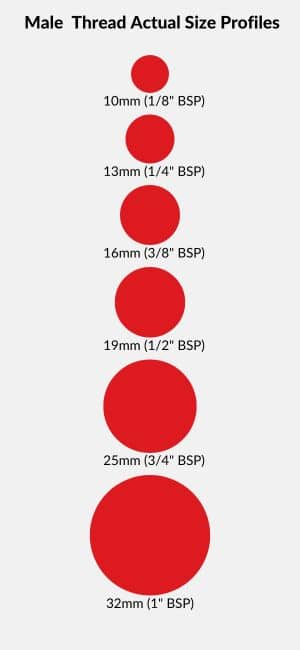
Measuring a Female Thread Coupling
If you did need to measure a female air fitting, this is how to do it:
- Use a ruler to measure across the inside diameter of the thread and note the measurement in millimetres.
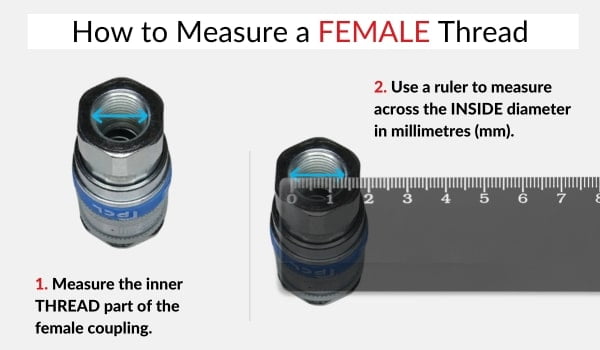
Step 2: Convert the measurement
Once you have the measurement of your male or female thread in millimetres, simply take a look at the conversion chart below to see what size that translates to in BSP (or BSPP / BSPT).
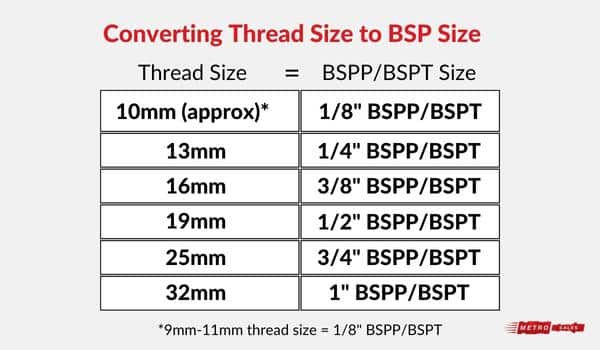
So now that we have busted some industry jargon and learned how to convert the thread size of a fitting to BSP, let’s take a look at air compressor fittings in a little more detail.
What are quick couplings?
Quick couplings are what we use in the compressed air industry to attach an air hose to an application such as an air tool (for example and air impact wrench). The benefits of having quick couplings means you can switch from one tool to another quickly and efficiently.
What is the difference between Male and Female Compressor Fittings?
A full air component is made up of two parts, the socket (female) and the plug (male). You would usually attach the female fitting onto the air hose end. Similarly, the male fitting is usually attached to the end of the air tool.
The easiest way to tell the difference between a male and female compressor fitting is by looking at the end. A male fitting has a visible thread and a female has a thread INSIDE the base (which perfectly connects with the male thread when attached).
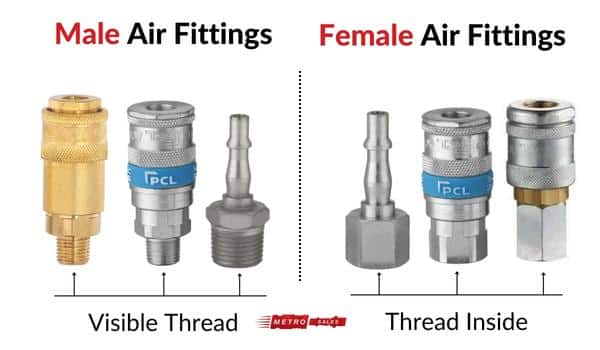
How do I know what compressed air fitting I need?
As previously mentioned, you will firstly need to know the size of the thread. This is the part that fits on to a compressor, air hose or application and is applicable to both male and female fittings. The male thread is visible as it forms the connection whereas the female ‘thread’ is internal (within the fitting).
We’ve already discussed how to measure a thread, the size you need may depend on the compressor and air tools you already have.
Most standard applications such as air tools require either a ¼” or ½” BSP depending on how big the tool is. In other words, the more heavy duty it is the more likely the BSP size will be higher. Fear not though, any good manufacturer will label the sizes you need for their tools and applications.
Secondly, it may also be useful to know nominal bore size.
Important to note: Nominal Bore size is NOT the same as the thread size. The nominal bore is the size of the hole which the compressed air passes through.
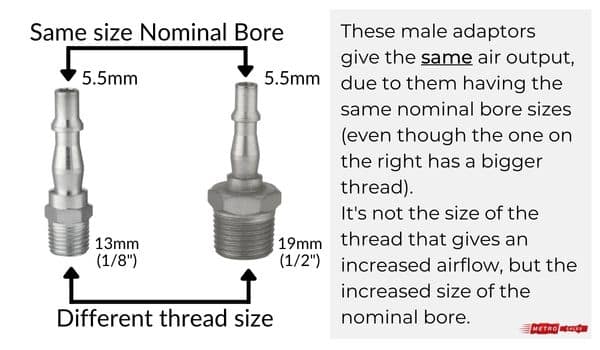
Nominal Bore Sizes
A standard adaptor has a nominal bore of 5.5mm, this is used for most air tools and applications that you would find in a garage or for your compressor at home. Some of the most popular couplings that fit into a standard adaptor include the PCL Airflow range, Vertex couplings and the non-corrodible fittings range.
The popular XF couplings & adaptors range from PCL have a slightly higher nominal bore of 7.2mm, thus, they are known as the “high flow” range. In other words, the flow of air is around a third more than those in the standard range.
As a rule of thumb, if you are working with bigger machinery then you will need couplings and adaptors with a bigger nominal bore.
To get a clearer understanding of the differences between the standard ranges from PCL (airflow & vertex) versus the higher flowing XF range, please take a look at the video below in which Gary explains the fittings.
Identifying your Adaptor profile
If you have been buying generic air couplings & adaptors, you may have noticed that there are no etchings on them to identify what kind of coupling it is. This is one reason why we always recommend PCL air fittings as they are clearly branded.
It’s important to be able to identify the profile of your adaptors (please refer to the actual size profile adaptor graphic above) so that you can ensure you are using the correct air flow required for your tool or application. Always check that your compressor fittings do not pass too little or too much air through for your chosen tool. Thankfully, all tools and applications bought from a reputable company (like us!) will have the information required about flow rates and maximum working pressures.
If you are looking to buy any air tools, workshop equipment or indeed compressors then we are happy to advise you with what size air fittings you will need, just give us a call: 01932 348777
Air Hose Compression Fittings
Sometimes you may need a more elaborate set up for your air compressor system. It’s not uncommon to want to include additional equipment to your hose line such as air treatment filters before your hose is connected to your desired air tool or application. Or you may wish to split your main hose airline into two separate hose airlines to enable the use of two air tools.
In cases such as this, you may need additional air hose fittings.
>> Read our Guide to Air Hoses here
You can get various air hose compression fittings, for example if you needed to fit a male component to another male component (or female to female). Another popular air fitting changes the direction of your airline (using elbow fittings) this is popular when designing an air system set up. When working from short air hoses and wanting to extend, often fittings to join hoses together is the most practical way to do it (rather than disconnecting everything you already have set up to attach a longer hose). As an illustration, we have shown a few of these fittings below.
Hose Connectors
Hose Connectors
Hose Connectors
Hose Connectors
< Shop for Air Hose Fittings | Read our Guide to Air Hoses >
Barbed Hosetail Air Fitting
The barbed tail fittings connect INSIDE the air hose, these are known as a hosetail. If you could see how a hosetail air fitting connects into an air hose, it would look like this:
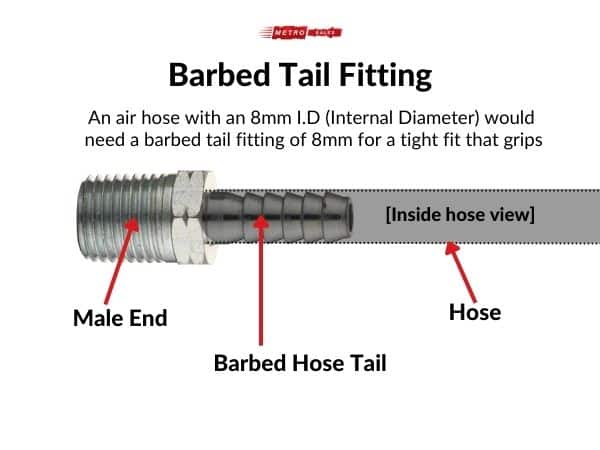
Barbed hosetail fittings like this also require hose fastenings (or clamps) to clamp on the outside of hose where the barbed hosetail sits within it to make sure it is tightly secured.
Push Fittings
When using air tubing, you will most likely want to create a set up where air can flow freely around a desired space or area. The easiest way to create such a set-up is with push fittings. In short, the air tube can simply be “pushed in” to a push fitting without the need of any other type of connector to seal it.
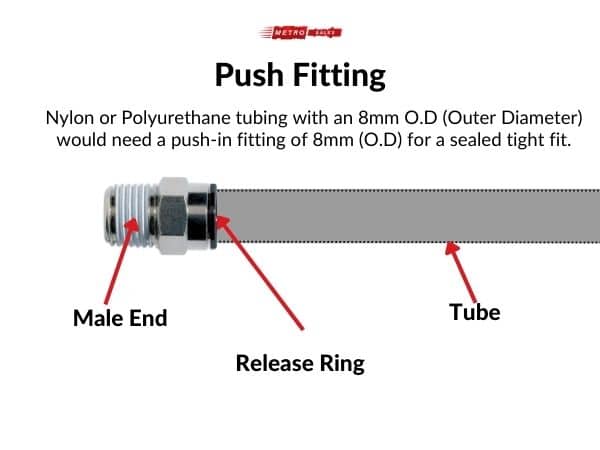
Pushing in the release ring and pulling the tube will allow the tube to be released quickly and easily.
Help with Air Compressor Fittings
We completely understand that air fittings are confusing! That’s why we encourage you to give us a call: 01932 348777 with any questions you have regarding couplings and adaptors. Whether you visit us in our Surrey air compressor shop, or buy from us online, we want to make sure you get the right equipment first time – every time! So, please don’t hesitate to contact us, we are more than happy to help you.



